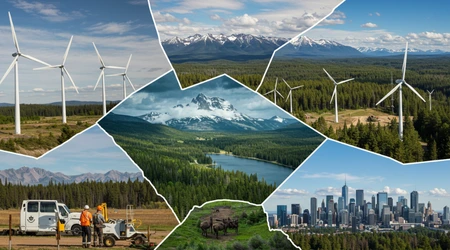Canada’s Response to Climate Objectives: Key Legislation & Environmental Initiatives

The year 2025 stands as a critical juncture for Canada’s Response to Climate Objectives, pushing the nation into a phase of difficult, high-stakes implementation.
After years of policy design, including the landmark Canadian Net-Zero Emissions Accountability Act, the country now faces the reality of meeting its ambitious 2030 targets.
The national commitment to reduce greenhouse gas emissions by 40-45% below 2005 levels by 2030 requires rapid, structural economic shifts. We must look beyond rhetoric to the current status of key legislation and the hard numbers demonstrating progress or the lack thereof.
A recent, unprecedented warning from the Canadian Climate Institute (CCI) suggests that, as of late 2024, Canada will not meet its 2030 climate target.
This chilling assessment means the “easy wins” have been achieved, and the nation must now tackle emissions from its most challenging sectors, namely oil and gas.
The political and economic pressure on the government to close the widening gap between targets and reality defines the current climate agenda.
What Key Legislation Drives Canada’s Climate Action?
The foundational legal framework for Canada’s climate aspirations is the Canadian Net-Zero Emissions Accountability Act (CNZEAA), which mandates specific targets and reporting requirements.
How Does the Net-Zero Emissions Accountability Act Function?
The CNZEAA, which became law in 2021, legally enshrines the country’s commitment to achieve net-zero emissions by 2050. Crucially, it mandates periodic reports, setting milestone years for progress checks.
One major reporting deadline is fast approaching: the end of 2025. The Minister must prepare a progress report assessing the 2030 target based on the latest scientific and technological developments.
This process ensures government accountability and transparency, forcing an official, public reckoning with the nation’s environmental performance every two years. The legislation itself dictates the rhythm and scrutiny applied to Canada’s Response to Climate Objectives.
++ Breaking Down Canada’s Latest Immigration Policy Changes & What They Mean for Aspirants
What is the Significance of the 2025 Progress Report?
The upcoming 2025 progress report is a critical assessment point under the CNZEAA. It must explicitly evaluate the current feasibility of the 2030 target.
The report also requires the Minister to consider whether the 2030 target must be adjusted, potentially strengthening it based on global scientific developments. This process holds significant political weight as the country approaches an expected 2025 federal election.
This mandatory public review is intended to galvanize action, preventing climate objectives from becoming mere political slogans. Without legally mandated reporting, governmental inertia could allow the targets to drift further out of reach.

What Has Happened with Canada’s Carbon Pricing System in 2025?
Carbon pricing remains the centerpiece of the national strategy, although its structure saw a major, highly contentious change in early 2025.
Why Was the Consumer Carbon Price Eliminated in Early 2025?
In a significant political move, the federal government announced its intention in March 2025 to refocus carbon pricing. They effectively eliminated the consumer-facing federal fuel charge, setting the price to zero effective April 1, 2025.
This decision was driven by intense political and public pressure over the cost-of-living crisis and rising fuel prices. The elimination aimed to provide immediate relief to households, particularly in swing provinces.
The change signals a shift toward relying heavily on the industrial carbon price the Output-Based Pricing System (OBPS) to achieve the bulk of the required emissions reductions. This fundamental alteration reshapes Canada’s Response to Climate Objectives.
How Does the Industrial Carbon Price Remain Effective?
The industrial carbon price, applied to major emitting facilities like those in the oil and gas sector, remains fully intact and is scheduled to continue increasing annually. This system accounts for a significant portion of the projected 2030 emissions reductions.
The industrial system is designed to maximize reductions while protecting competitive and trade-exposed sectors from being overly penalized. It requires large emitters to meet a benchmark or purchase compliance credits.
This strategic focusing of the carbon price leverages the principle that the heaviest polluters should face the highest cost, ensuring that large-scale industrial decarbonization remains the primary driver of emission cuts.
Read more: How does the Bank of Canada interest rate affect your portfolio?
What is the Economic Risk of the Policy Shift?
By removing the consumer incentive (or deterrent), the government risks losing emissions reductions from millions of household and vehicle decisions. This choice places a disproportionate burden on industrial innovation alone.
This policy adjustment raises questions about the government’s commitment to a universal price signal, potentially complicating future reviews of the federal carbon pricing benchmark scheduled for 2026. This is a massive test for Canada’s Response to Climate Objectives.
Where Does Progress Stall: The Critical Sector Challenges?
While emissions have dropped in some sectors like electricity and heavy industry, progress has been offset by increases elsewhere, creating the current deficit toward the 2030 goal.
Why is the Oil and Gas Sector the Biggest Obstacle?
The oil and gas sector remains the single largest source of greenhouse gas emissions in Canada, representing the most intractable policy challenge. Increases in oil sands production are currently nullifying gains made in other sectors.
Is the Oil and Gas Emissions Cap Finally Ready?
Regulations for the promised cap on oil and gas sector emissions were consulted upon in 2024 and are due to be finalized in 2025. Its successful implementation is viewed as essential for meeting the 2030 target.
However, the government has repeatedly suggested the cap can be achieved alongside continued, and sometimes increased, production. This ambition is viewed skeptically by many environmental policy experts.
The Challenge of the “Last Mile” Reductions
A leading climate think-tank stated in late 2024 that the reductions required to hit the 2030 target now require lowering emissions by 40 megatonnes (Mt CO2e) a year. This is an unprecedented rate of reduction.
Data Point: The Canadian Climate Institute reported in September 2025 that Canada’s emissions are only 8.5% below 2005 levels, a vast distance from the targeted 40-45% reduction.
Analogy: Canada’s Response to Climate Objectives is like a long-distance runner who has successfully completed the flat middle section of the race but is now facing a massive, unforeseen incline with only a small number of kilometers remaining. A massive acceleration is required.
What New Environmental Initiatives Are Underway in 2025?
Beyond the major legislation, new targeted initiatives and regulatory changes are being implemented to drive sector-specific reductions and adapt to climate change impacts.
How is Canada Addressing Cross-Sectoral Emissions?
Targeted policies are being developed to address specific high-impact emissions sources, demonstrating a granular approach to reducing the national carbon footprint.
he Electric Vehicle (EV) Sales Mandate
New regulations are pushing the automotive sector hard: the EV sales mandate targets 60% of all new passenger car and light-duty truck sales to be electric by 2030. This policy aggressively forces market transition.
This mandate provides a clear, non-negotiable directive to manufacturers and will rapidly change the Canadian vehicle fleet composition over the next five years.
Green Buildings and Adaptation Strategy
Canada is moving toward a ‘net-zero energy ready’ building code for new construction by 2032 and is increasing the rate of deep building retrofits. The building sector is a critical area for efficiency gains.
Furthermore, a National Adaptation Strategy is being finalized to help communities prepare for the physical impacts of climate change, which are increasing yearly. In 2024, insured damage from severe weather surpassed $8 billion, underscoring the urgency of adaptation.
Example: The creation of the new Canada Water Agency highlights the critical need to manage increasing drought and flood risks, demonstrating that climate action extends beyond just reducing emissions.
Canada’s Key Emissions Reduction Targets and Progress Status (2025)
| Metric | Target/Goal | Status in Late 2025 (CCI Estimate) | Challenge Level |
| 2030 GHG Reduction | 40-45% below 2005 levels | Estimated shortfall; only 8.5% reduced. | High |
| Net-Zero Goal | Net-Zero Emissions by 2050 | Legally enshrined by CNZEAA. | Ongoing |
| Consumer Carbon Price | Price increases to $95/tonne (Scheduled) | Price set to zero as of April 1, 2025. | Policy Shift |
| EV Sales Mandate | 60% of new sales by 2030 | Strong regulatory push underway. | Medium-High |
Conclusion: Commitment Meets Reality
Canada’s Response to Climate Objectives is clearly defined by strong legislative intent the CNZEAA but is struggling against the weight of economic and political realities.
The elimination of the consumer carbon price and the persistent emissions from the oil and gas sector highlight the immense challenge ahead.
Achieving the 2030 target now depends entirely on the swift, uncompromising finalization and enforcement of industrial regulations, especially the oil and gas emissions cap. The political will demonstrated in 2025 will determine the environmental legacy of the nation.
Will the federal government enforce the industrial cap needed to close the 40 Mt CO2e gap, or will economic pressures prevail? Share your perspective on the greatest hurdle facing Canada’s climate targets in the comments below.
Frequently Asked Questions (FAQ)
Q: Does the elimination of the consumer carbon price mean pollution is no longer priced?
A: No. The consumer fuel charge was zeroed out, but the industrial carbon price (OBPS) remains in full effect. The focus has simply shifted to prioritizing large industrial emitters over households for the price signal.
Q: What is the significance of the 2005 baseline year for Canada’s Response to Climate Objectives?
A: Canada adopted the 2005 baseline year for its emissions reduction targets under the Paris Agreement. This choice is crucial as it defines the starting point against which the required 40-45% reduction is measured.
Q: What is the “greenwashing” legislation mentioned in recent reports?
A: In June 2024, Bill C-59 was passed to strengthen consumer protections against ‘greenwashing.’ This legislation aims to ensure Canadian entities are truthful and substantiated when making environmental claims about their products or operations.
